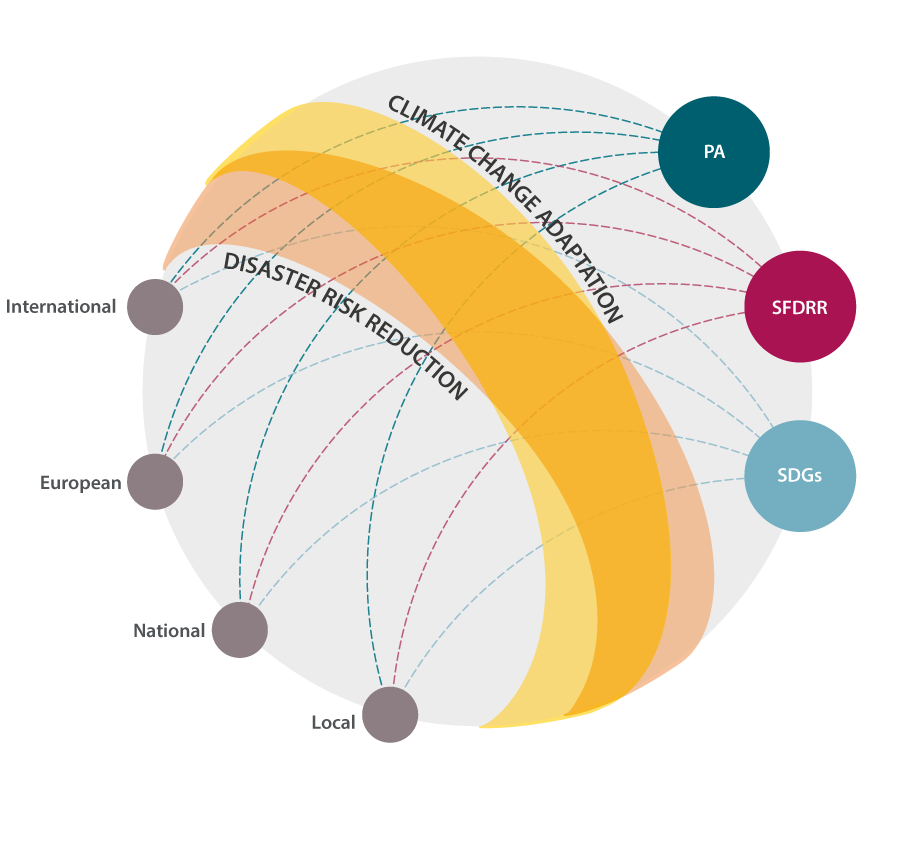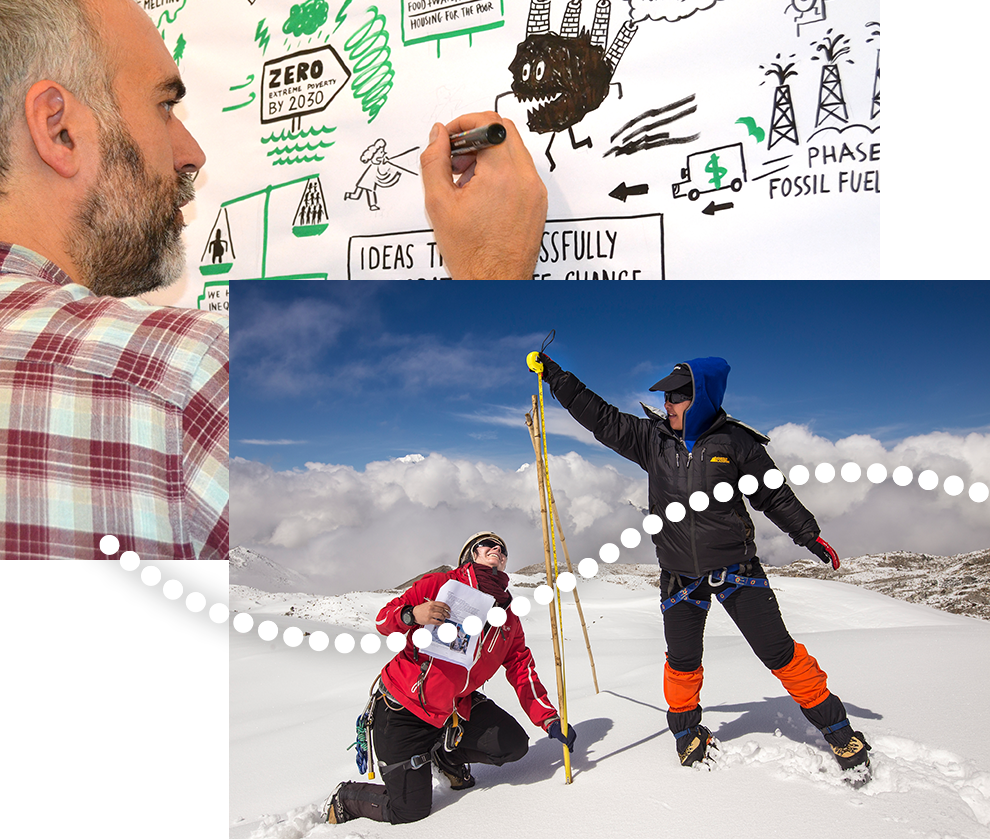Strengthening institutional coordination & capacities – bonding climate change adaptation and disaster risk reduction

Introduction
“Our house is on fire”, climate activist Greta Thunberg declared to the participants of the World Economic Forum in Davos in January 2020. Climate-induced extreme weather events are currently increasing and intensifying, thereby leading to new forms of disaster risk. In order to sustainably extinguish this metaphorical fire, separated strategies are no longer enough.
Responding to short term climate risks without considering the long-term climate trends, and viceversa, is no longer an acceptable course of action, as it separates (knowledge and financial) resources that should belong together. However, integrated approaches to disaster risk reduction (DRR) and climate change adaptation (CCA) can provide opportunities for building resilience.
This guidance, developed by the PLACARD project, brings together hands-on experience from twenty-eight CCA and DRR experts across Europe. It is based on experience gained during the project (2015–2020) and provides insights and inspiration through showcasing innovative activities that target cooperation, collaboration, improved communication, increased coherence, and capacity-sharing between the CCA and DRR communities. The guidance aims to foster cooperation between institutions to strengthen interaction and collaboration.
The guidance provides twenty recommendations forstrengthening institutional coordination and capacities, in five areas: 1) safeguarding sound governance, 2) ensuring effective financing, 3) seizing opportunities for cooperation, 4) sharing new forms of communication, and 5) enhancing knowledge management.
*Download the full publication from the right hand column. The key messages from the publication are provided below. See the full text for much more detail.
Recommendations
1. Safeguarding sound governance
- Challenge: Separated decision-making processes and knowledge communities with different languages reduce the possibility of quickly joining resources in extreme events preparedness, when extreme events occur, and to plan for the long term when no emergency assistance is being deployed.
- Recommendation: Implementation of a comprehensive Climate Risk Management (CRM) approach with broad stakeholder involvement at and across different risk governance levels
- Challenge: Separated user and stakeholder engagement processes and taxonomies applied by knowledge and policy communities creates difficulties in establishing proper research and practice communication channels, even if the target agents are common.
- Recommendation: Engage stakeholders at different scales that have an interest in both the decision-making process and outcomes.
- Challenge: By focusing mainly on public policy and decisionmaking CCA and DRR communities often neglect private actors that can provide substantial contributions in case of disasters and planning for the long term.
- Recommendation: Develop a stronger focus on self-safeguards or individual prevention and preparedness.
- Challenge: By failing to capture local knowledge in the preparedness and planning phases many CCA and DRR strategies miss out on valuable data, lessons and experiences that can enhance climate action.
- Recommendation: Implement integrated, participatory designed strategies and plans at the municipal level that deal with climateinduced disasters
2. Ensuring effective financing
- Challenge: New funding and insuring methods are needed to address climate risks and adaptation not previously covered by classical risk sharing schemes.
- Recommendation: Create Sovereign Climate Insurance Funds with application of index-based insurance and Distributed Ledger Technology.
- Challenge: New risk transference methods are needed to address climate risks and adaptation not previously covered by classical market-based financial debt instruments.
- Recommendation: Develop risk transfer and data collection via a European Risk Transfer Mechanism
- Challenge: Current market and policy terminologies are not fitfor-purpose for upcoming transaction of financial assets associated with climate action.
- Recommendation: Implement an EU Green Taxonomy with CCA and DRR components.
- Challenge: Current forecasting methods focus on what the weather ‘will be’ rather than what the weather ‘will cause’ leaving room for improvements in early warning systems and preparedness mechanisms.
- Recommendation: Pursue forecast-based financing to anticipate disasters and reduce human suffering and losses.
- Challenge: Existing financial and debt financing mechanisms in the area of CCA and DRR are still not up-to-speed with climate funding needs at local-to-national scales.
- Recommendation: Elaborate self-financing and crisis financing mechanisms with application of Distributed Ledger Technologies
3. Seizing opportunities for cooperation
- Challenge: Cross-country governance mechanisms for climate and disaster risk management are lacking or do not share common practices.
- Recommendation: Develop a strong transnational and interregional collaboration between CCA and DRR with a joint focus on current and future risks.
- Challenge: Effective communication and collaboration across CCA and DRR knowledge communities is hindered by separated taxonomies and networking mechanisms between groups of actors.
- Recommendation: Use Social Network Analysis for stocktaking of stakeholders and to enhance interactions.
- Challenge: Joint emergency and preparedness exercises that include both communities are lacking, which reduces learning opportunities.
- Recommendation: Organise joint emergency exercises to strengthen collaboration on various levels.
- Challenge: Transboundary climate and preparedness action is challenging due to different languages and cultural settings making it reactive rather than proactive.
- Recommendation: Pursue proactive transboundary cooperation between CCA and DRR actors.
4. Sharing new forms of communication
- Challenge: Monitoring, Reporting and Evaluation (MRE) frameworks for CCA, DRR and sustainable development policies are disconnected and multiply the use of resources.
- Recommendation: Foster a dialogue and learning on monitoring, reporting and evaluation.
- Challenge: The use of storytelling, strategic narratives and art processes is residual across CCA and DRR communities and crosscommunity collaborative schemes are almost non-existing.
- Recommendation: Develop new stories and strategic narratives for joint understanding and collaboration.
- Challenge: Educational and capacity building mechanisms suffer from community silo approaches that reduce learning over time, across and within organisations.
- Recommendation: Mainstream integrated approaches through education.
5. Enhancing knowledge management
- Challenge: Effective deployment of nature-based solutions (NbS) in adaptation and risk reduction strategies is still too complex because of the required level of cross-sectoral collaboration and multistakeholder coordination.
- Recommendation: Foster ecosystem-based adaptation and risk reduction.
- Challenge: Information and knowledge management (IKM) processes across CCA and DRR communities are hindered by lack of clarity around language and the use of technical terminology.
- Recommendation: Promote IKM standards and guidelines for sharing data, information and knowledge.
- Challenge: CCA and DRR knowledge portals and platforms are not fulfilling their true potential regarding learning, practical implementation, monitoring and evaluation of climate preparedness and action.
- Recommendation: Use knowledge platforms and portals to enhance learning and collaboration.
- Challenge: Significant comprehension and communication gaps between CCA and DRR knowledge producers, providers, and users, as well as between science, policy, and practice persists hindering the effective use of information for practical decisions.
- Recommendation: Develop knowledge-action networks to advance quality and usage of information.
*Please refer to the full guidance for more details, including on the prevailing knowledge and action gaps, reflections and conclusions.

Comments
There is no contentYou must be logged in to reply.